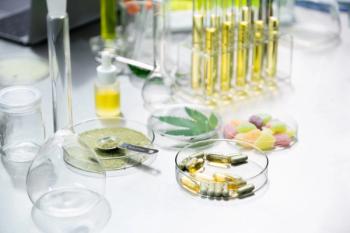
Cannabis Science and Technology
- April 2022
- Volume 5
- Issue 3
- Pages: 10-14
Beer’s Law, Part II: Physical Basis and Derivation

In part II of this series, we establish the physical basis of Beer’s Law and derive it from first principles then wrap up with a discussion of how the assumptions made in the derivation affect Beer’s Law experiments.
In my last column, I introduced Beer’s Law, which allows high performance liquid chromatography (HPLC) and infrared spectroscopy to be used to measure potency in cannabis samples. In this column, I establish the physical basis of Beer’s Law and derive it from first principles. I wrap up with a discussion of how the assumptions made in the derivation affect Beer’s Law experiments.
Review
Beer’s Law allows spectroscopy to be quantitative because it relates the amount of light absorbed by a sample to the concentration of chemical species in that sample (1). From last time, Beer’s Law has the form of Equation 1 (1):
where A is the absorbance; ε is the absorptivity; L is the pathlength; and C is the concentration.
Spectroscopy is the study of the interaction of light with matter (2), so to understand Beer’s Law at a fundamental physical level, we need to think about light and how it interacts with molecules.
Light is properly called electromagnetic radiation because it consists of electric and magnetic waves undulating in mutually perpendicular planes (2). Although technically the term “light” is often used to refer to the electromagnetic radiation we can see with our eyes, I will be lazy and use it to refer to all electromagnetic radiation. Light is a mysterious devil since depending on what phenomenon of light is being measured it can be thought of as a wave or particle (3). For the purposes of this column, we will think of light as a particle. A particle of light is called a photon, like the photon torpedoes in Star Trek. A photon of light has energy but no mass, and its energy is given by Equation 2 (3):
where Ep is the energy of a photon; h is Planck’s constant; c is the speed of light; and W is wavenumber.
Briefly, the wavenumber W of light is 1/wavelength, and if wavelength is measured in cm, then W has units of cm-1. The x-axis of spectra are often plotted in wavelength or wavenumber units. An example of the mid-infrared spectrum of a cannabis bud is seen in Figure 1.
Note that the x-axis of Figure 1 is in wavenumber units, and that the y-axis is in absorbance. Note that when plotted in absorbance the peaks point up, and the tops of the peaks denote wavenumbers where a significant amount of light is absorbed. The absorbance here is the same as the A in Equation 1 above, and yes, the peak heights and areas in Figure 1 can be used to determine the potency of cannabis plant material (4-6).
When Photons and Molecules Collide
When thinking of light as a photon, we can picture its interaction with molecules as that of a collision. Figure 2 illustrates a photon about to collide with a methane molecule.
For simplicity’s sake, I have represented the methane molecule as a simple sphere. However, methane has a tetrahedral structure (7).
Physicists define different types of collisions based on what happens to the energy in the photon as a result of the collision (3). In Figure 2 before colliding with the methane molecule the photon has energy Ep, and to make life simple we will assume the methane molecule is at rest and has no energy. In what is called an elastic collision, no energy is exchanged between the methane molecule and the photon, and the photon leaves the collision with energy Ep and the methane molecule is still at rest. Note in Figure 2 that the direction of the photon does change. Elastic collisions between photons and molecules give rise to a phenomenon called Rayleigh scattering (8). The intensity of Rayleigh scattering is proportional to the fourth power of the wavenumber, or W4, of the light being scattered. Rayleigh scattering is why the sky is blue; blue visible light is the highest wavenumber light we can see and is scattered with more intensity than all other visible light. Although Rayleigh scattering gives us a beautiful sky, it does not provide us with much chemical information.
Figure 3 illustrates that is called an inelastic collision between a molecule and a photon.
During an inelastic collision the photon changes direction and loses some energy to the methane molecule, exciting it vibrationally. The amount of vibrational energy obtained by the methane molecule, Ev, must be equal to the amount of energy lost by the photon to maintain conservation of energy. After the collision the total amount of energy in the system is the sum of the energies of the photon and molecule, Etotal, such as seen in Equation 3:
And the amount of energy the photon now has is given by Equation 4:
The collision of the photon and molecule exciting the molecule vibrationally is analogous to hitting a bell with a hammer, where the photon is the hammer, and the methane molecule is the bell. Some of the hammer’s energy is transferred to the methane molecule causing it to vibrate or “ring.”
The inelastic scattering of photons by molecules is called Raman scattering (9). Analysis of Raman scattered photons provides chemical structural information about molecules, like how infrared spectroscopy provides this information. Raman spectroscopy is a well-developed field of chemical analysis (9) and has been used to analyze cannabis plant material (10-12).
Figure 4 shows what happens when all the energy in a photon-molecule collision is transferred from the photon to the molecule. This is called a totally inelastic collision.
Again, since the Law of Conservation of Energy must be followed, and all the photon’s energy is deposited into the methane, the final energy of the methane molecule is then Ep. As a result of a totally inelastic collision, the methane molecule can vibrate similar to the result of an inelastic collision. Since the methane molecule absorbs all the photon’s energy, inelastic collisions give rise to a phenomenon known as absorbance—yes, the A in Beer’s Law in Equation 1 above.
The Derivation of Beer’s Law
When a beam of photons travels through a sample of matter, let’s say a gas or liquid to make things simple, how many photon-molecule collisions occur? Intuitively, the more photons there are passing through a sample the more collisions there will be, and the number of photons a light beam contains is simply its intensity (I). Similarly, the more molecules there are in a sample the more photon-molecule collisions there will be. The number of molecules in a sample is determined by its concentration (C).
How do we quantify these ideas? Consider Figure 5, which should look familiar as it was in the last column as well (1). This is an example of an experimental setup commonly used in Beer’s Law experiments.
In Figure 5, λ is the wavelength of light passing through the sample; I0 is the measured light intensity before the light beam enters the sample; I is the measured light intensity after the light beam has exited the sample; L is the pathlength or sample thickness; and dL is an infinitesimally thin slab of the sample.
In Figure 5, the light beam of single wavelength l and intensity I0 impinges perpendicular to the face of a sample. The light beam leaves the sample at the same wavelength l but with intensity I. Light intensity has been lost by collisions between photons and molecules. L is the pathlength or sample thickness, and dL is an infinitesimally thin slab of the sample. As stated above, the number of collisions depends upon the number of photons, the number of molecules, and the pathlength—the thicker the sample, the higher the probability a photon will encounter a molecule. If we let -dI represent the light intensity lost by photon-molecule collisions, we can write proportionality Equation 5 as such:
where dI is the amount of light lost to all scattering; I is the light intensity in slab dL; C is the concentration; and dL is the infinitesimally thin slab of sample.
Proportionality, Equation 5 simply shows that the amount of light lost depends on the total number of photon-molecule collisions, which depends upon the number of photons I, the concentration of molecules C, and the thickness of our sample slab dL. Now, remember that Beer’s Law deals with absorbance, and that absorbance is due to totally inelastic collisions only. So, to measure the total absorbance we would need to know the number of totally inelastic collisions, or in other words what fraction of photon-molecule collisions are totally inelastic. This fraction is given by the absorptivity, e, yes, the same absorptivity that we discussed last time (1) and that appears in Equation 1 above. By inserting e into proportionality Equation 5, we obtain Equation 6, which gives the amount of light intensity lost due to totally inelastic collisions, or absorbance, as such:
where dI is the amount of light lost in totally inelastic collisions; e is the absorptivity; I is the light intensity in slab dL; C is the concentration; and dL is the infinitesimally thin slab of sample.
At this point in the derivation, we need to get from Equation 6 to the final form of Beer’s Law. This necessitates using calculus to integrate both sides of Equation 6. I will not go into the math here—consult my book on quantitative spectroscopy for the details (3). Long story short we end up with Equation 7, which is Beer’s Law:
where A is the absorbance; e is the absorptivity; L is the pathlength; and C is the concentration.
Assumptions Behind Beer’s Law
In the derivation of Beer’s Law several assumptions must be made, which effects how quantitative spectroscopy experiments are performed (3). These assumptions are:
- The light beam contains only 1 wavelength, which is wavelength λ. We normally use a light beam containing many wavelengths in it to measure spectra. Fortunately, using light beams with many wavelengths in them generally presents no problems.
- The sample is homogeneous. Remember we started with a slab dL, of the sample. The assumption in the derivation is that all such slabs dL are identical. This means we are assuming that all parts of the sample are the same, and that the concentration of the absorbing species is the same everywhere in the sample as well. We are also assuming that the physical condition, things such as temperature and pressure, is the same in all portions of the sample. Insuring sample homogeneity is normally not a problem for gases and liquids, which can be stirred and mixed easily. However, for a solid such as a cannabis bud, even one that has been ground, most certainly the sample is not homogeneous. That is why, for example, when using infrared spectroscopy to determine potency in dried, ground cannabis multiple portions of the sample are scanned, and the results are averaged to obtain representative data on the sample (5-6).
- Our derivation of Beer’s Law assumes that all loss of photons in the sample is from totally inelastic collisions. Commercial spectrometers cannot distinguish between light lost by absorbance, Rayleigh scattering, or Raman scattering. Additionally, there are light losses because of reflections and absorbance by sample cell materials, contaminants on sample cell windows absorbing, suspended particles of dirt and dust that can scatter photons, and contaminant chemical species that can absorb. Since the spectrometer can’t tell the difference between all these sources of light loss, one needs to control or eliminate as many of these sources as possible. For sample cell contributions, one can scan a “background” scan of an empty cell, and if this contribution is the same from background to sample it is ok. Suspended crud should be filtered from gas and liquid samples, not so easy for solids. Lastly, make sure your sample does not contain impurities that can interfere with the measurement of the absorbance of your chemical species of interest.
Conclusion
Using the idea of photon-molecule collisions, we showed how totally inelastic collisions lead to light absorbance. Then, using the number of photons and molecules present, we wrote a proportionality which gave us the total number of photon-molecule collisions. Next, by inserting the absorptivity, which is the fraction of collisions that are totally inelastic we derived Beer’s Law. Lastly, the assumptions made in the derivation and how they affect real world experiments were discussed.
References
- B. Smith, Cannabis Science and Technology 5(2), 10-13 (2022).
- Brian C. Smith, Fundamentals of Fourier Transform Infrared Spectroscopy 2nd Ed. (CRC Press, Boca Raton, Florida, 2011).
- Brian C. Smith, Quantitative Spectroscopy: Theory and Practice (Elsevier, Boston, Massachusetts, 2002).
- B.C. Smith, M. Lewis, and J. Mendez, “Optimization of Cannabis Grows Using Fourier Transform Mid-Infrared Spectroscopy,” PerkinElmer Application Note (2016).
- Brian C. Smith, Cannabis Science and Technology 2(6), 10-14 (2019).
- B.C. Smith and C. Fucetola, Cannabis Science and Technology3(6), 24-38 (2020).
- A. Streitweiser and C. Heathcock, Introduction to Organic Chemistry (Macmillan, New York, New York, 1976).
- Rayleigh scattering - Wikipedia
https://en.wikipedia.org/wiki/Rayleigh_scattering . - Raman scattering - Wikipedia
https://en.wikipedia.org/wiki/Raman_scattering . - L. Sanchez, C. Filter, D. Baltensperger, and D. Kurouski, RSC Advances 10, 3212 (2020).
- M. L’Heureux and M. Colli, (interview with D. Kurouski), Cannabis Science and Technology 3(3), 53-54 (2020).
https://mariposatechnology.com/ .
About the Columnist
Brian C. Smith, PhD, is Founder, CEO, and Chief Technical Officer of Big Sur Scientific. He is the inventor of the BSS series of patented mid-infrared based cannabis analyzers. Dr. Smith has done pioneering research and published numerous peer-reviewed papers on the application of mid-infrared spectroscopy to cannabis analysis, and sits on the editorial board of Cannabis Science and Technology®. He has worked as a laboratory director for a cannabis extractor, as an analytical chemist for Waters Associates and PerkinElmer, and as an analytical instrument salesperson. He has more than 30 years of experience in chemical analysis and has written three books on the subject. Dr. Smith earned his PhD on physical chemistry from Dartmouth College.
Direct correspondence to:
How to Cite this Article:
B. Smith, Cannabis Science and Technology 5(3), 10-14 (2022).
Articles in this issue
over 3 years ago
What’s in a Vape, Part Iover 3 years ago
How Poor Environmental Control Creates Pest Pressureover 3 years ago
Cannabis Science Conference Honors the Wisdom of WomenNewsletter
Unlock the latest breakthroughs in cannabis science—subscribe now to get expert insights, research, and industry updates delivered to your inbox.




